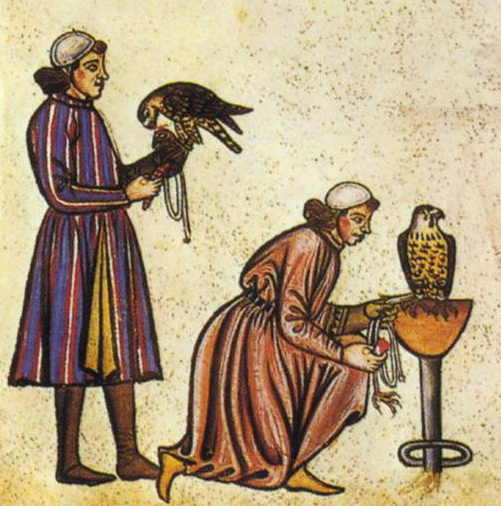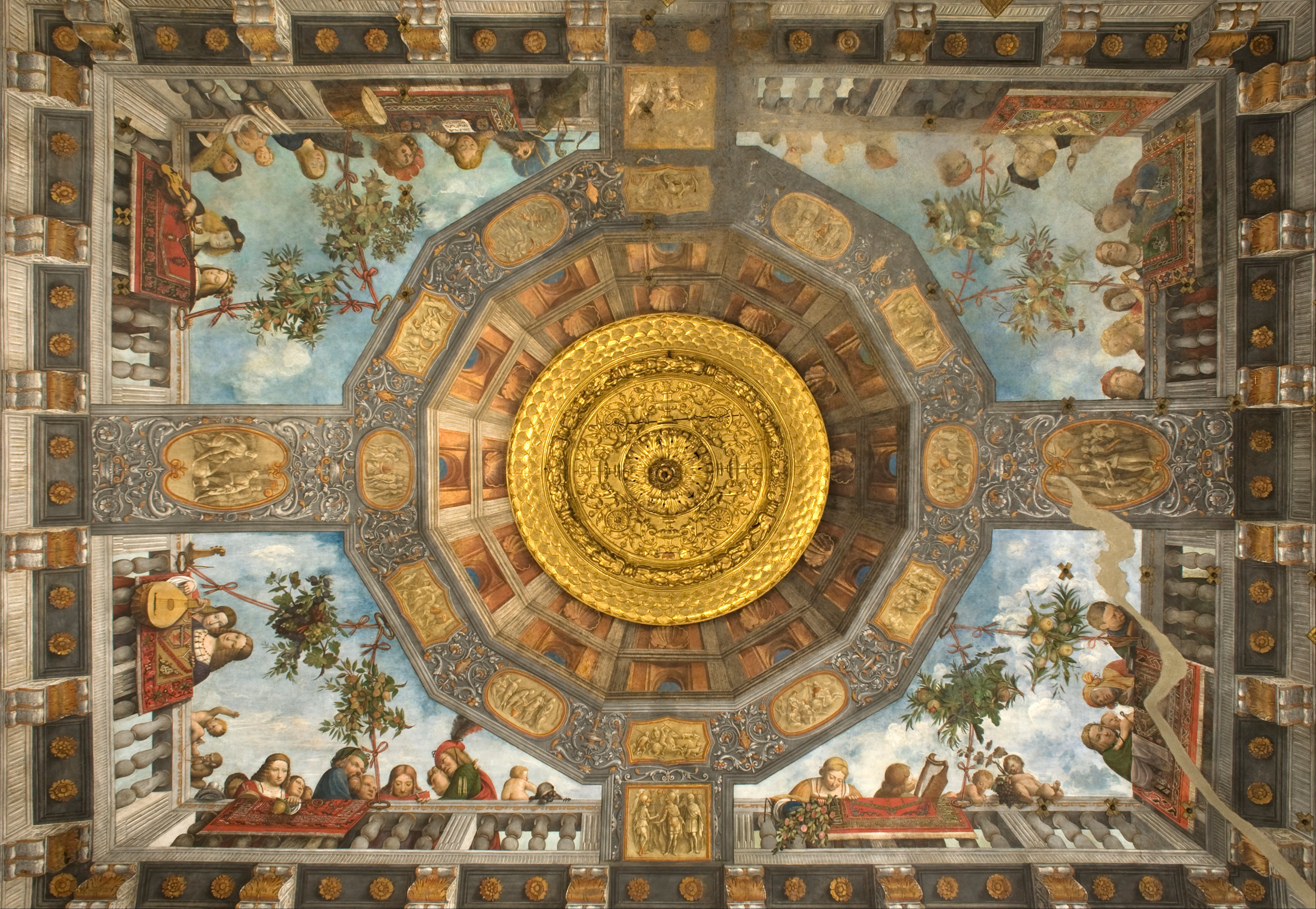|
Two Venetian Ladies
''Two Venetian Ladies'' is an oil on panel painting by the Italian Renaissance artist Vittore Carpaccio. The painting, believed to be a quarter of the original work, was executed around 1490 and shows two unknown Venetian ladies. The top portion of the panel, called ''Hunting on the Lagoon'' is in the Getty Museum, and another matching panel is missing. The painting was formerly considered to show two courtesans. Modern art historians think them more likely members to be of the patrician Torella family, as suggested by their fine clothes and the pearl necklaces, but academic debate continues, as with other similar Venetian paintings of the period. Several objects - the white kerchief, the pearls and the animals (the doves, Venus's bird) are symbols of chastity. Note the chopines, or platform clogs, on the left. Another painted panel, now in the Getty Museumbr> was published in 1944, and it was later realized that this is part of the same work, fitting above this part: it port ... [...More Info...] [...Related Items...] OR: [Wikipedia] [Google] [Baidu] |
Vittore Carpaccio
Vittore Carpaccio (British English, UK: Help:IPA/English, /kɑːrˈpætʃ(i)oʊ/, American English, US: Help:IPA/English, /-ˈpɑːtʃ-/, Italian: Help:IPA/Italian, [vitˈtoːre karˈpattʃo]; c. 1460/66 – 1525/26) was an Italians, Italian painter of the Venetian School (art), Venetian school who studied under Gentile Bellini. Carpaccio was largely influenced by the style of the early Italian Renaissance painter Antonello da Messina (c.1430-1479), as well as Early Netherlandish art, Early Netherlandish painting. Although often compared to his mentor Gentile Bellini, Vittore Carpaccio’s command of perspective, precise attention to architectural detail, themes of death, and use of bold color differentiated him from other Italian Renaissance artists. Many of his works display the religious themes and cross-cultural elements of art at the time; his portrayal of ''St. Augustine in His Study (Carpaccio), St. Augustine in His Study'' from 1502, reflects the popularity of collecting ... [...More Info...] [...Related Items...] OR: [Wikipedia] [Google] [Baidu] |
Cormorant
Phalacrocoracidae is a family of approximately 40 species of aquatic birds commonly known as cormorants and shags. Several different classifications of the family have been proposed, but in 2021 the IOC adopted a consensus taxonomy of seven genera. The great cormorant (''Phalacrocorax carbo'') and the common shag (''Gulosus aristotelis'') are the only two species of the family commonly encountered in Britain and Ireland and "cormorant" and "shag" appellations have been later assigned to different species in the family somewhat haphazardly. Cormorants and shags are medium-to-large birds, with body weight in the range of and wing span of . The majority of species have dark feathers. The bill is long, thin and hooked. Their feet have webbing between all four toes. All species are fish-eaters, catching the prey by diving from the surface. They are excellent divers, and under water they propel themselves with their feet with help from their wings; some cormorant species have been ... [...More Info...] [...Related Items...] OR: [Wikipedia] [Google] [Baidu] |
Dogs In Art
Cultural depictions of dogs in art has become more elaborate as individual breeds evolved and the relationships between human and canine developed. Hunting scenes were popular in the Middle Ages and the Renaissance. Dogs were depicted to symbolize guidance, protection, loyalty, fidelity, faithfulness, alertness, and love. As dogs became more domesticated, they were shown as companion animals, often painted sitting on a lady's lap. Throughout art history, mainly in Western art, there is an overwhelming presence of dogs as status symbols and pets in painting. The dogs were brought to houses and were allowed to live in the house. They were cherished as part of the family, and were regarded highly by the upper classes, who used them for hunting and could afford to feed them. Hunting dogs were generally connected to the aristocracy. Only the nobility were allowed to keep hunting dogs, and this would signal status. Dog portraits became increasingly popular in the 18th century, an ... [...More Info...] [...Related Items...] OR: [Wikipedia] [Google] [Baidu] |
Birds In Art
Human uses of birds have, for thousands of years, included both economic uses such as food, and symbolic uses such as art, music, and religion. In terms of economic uses, birds have been hunted for food since Palaeolithic times. They have been captured and bred as poultry to provide meat and eggs since at least the time of ancient Egypt. Some species have been used, too, to help locate or to catch food, as with cormorant fishing and the use of honeyguides. Feathers have long been used for bedding, as well as for quill pens and for fletching arrows. Today, many species face habitat loss and other threats caused by humans; bird conservation groups work to protect birds and to influence governments to do so. Birds have appeared in the mythologies and religions of many cultures since ancient Sumer. For example, the dove was the symbol of the ancient Mesopotamian goddess Inanna, the Canaanite mother goddess Asherah, and the Greek goddess Aphrodite. Athena, the Greek goddess of wisdo ... [...More Info...] [...Related Items...] OR: [Wikipedia] [Google] [Baidu] |
Collections Of The Museo Correr
Collection or Collections may refer to: * Cash collection, the function of an accounts receivable department * Collection (church), money donated by the congregation during a church service * Collection agency, agency to collect cash * Collections management (museum) ** Collection (museum), objects in a particular field forms the core basis for the museum ** Fonds in archives ** Private collection, sometimes just called "collection" * Collection (Oxford colleges), a beginning-of-term exam or Principal's Collections * Collection (horse), a horse carrying more weight on his hindquarters than his forehand * Collection (racehorse), an Irish-bred, Hong Kong based Thoroughbred racehorse * Collection (publishing), a gathering of books under the same title at the same publisher * Scientific collection, any systematic collection of objects for scientific study Collection may also refer to: Computing * Collection (abstract data type), the abstract concept of collections in computer sc ... [...More Info...] [...Related Items...] OR: [Wikipedia] [Google] [Baidu] |
Paintings By Vittore Carpaccio
Painting is the practice of applying paint, pigment, color or other medium to a solid surface (called the "matrix" or "support"). The medium is commonly applied to the base with a brush, but other implements, such as knives, sponges, and airbrushes, can be used. In art, the term ''painting ''describes both the act and the result of the action (the final work is called "a painting"). The support for paintings includes such surfaces as walls, paper, canvas, wood, glass, lacquer, pottery, leaf, copper and concrete, and the painting may incorporate multiple other materials, including sand, clay, paper, plaster, gold leaf, and even whole objects. Painting is an important form in the visual arts, bringing in elements such as drawing, composition, gesture (as in gestural painting), narration (as in narrative art), and abstraction (as in abstract art). Paintings can be naturalistic and representational (as in still life and landscape painting), photographic, abstract, narrative, sy ... [...More Info...] [...Related Items...] OR: [Wikipedia] [Google] [Baidu] |
1490s Paintings
*
{{Number disambiguation ...
149 may refer to: *149 (number), a natural number *AD 149, a year in the 2nd century AD *149 BC, a year in the 2nd century BC *British Airways Flight 149, a flight from LHR to Kuwait City International Airport; the aircraft flying this flight was destroyed by Iraqi troops See also * List of highways numbered 149 The following highways are numbered 149: Canada * Prince Edward Island Route 149 Costa Rica * National Route 149 (Costa Rica), National Route 149 India * National Highway 149 (India) Japan * Japan National Route 149 United States * Alabama St ... [...More Info...] [...Related Items...] OR: [Wikipedia] [Google] [Baidu] |
Trompe-l'œil
''Trompe-l'œil'' ( , ; ) is an artistic term for the highly realistic optical illusion of three-dimensional space and objects on a two-dimensional surface. ''Trompe l'oeil'', which is most often associated with painting, tricks the viewer into perceiving painted objects or spaces as real. Forced perspective is a related illusion in architecture. History in painting The phrase, which can also be spelled without the hyphen and ligature in English as ''trompe l'oeil'', originates with the artist Louis-Léopold Boilly, who used it as the title of a painting he exhibited in the Paris Salon of 1800. Although the term gained currency only in the early 19th century, the illusionistic technique associated with ''trompe-l'œil'' dates much further back. It was (and is) often employed in murals. Instances from Greek and Roman times are known, for instance in Pompeii. A typical ''trompe-l'œil'' mural might depict a window, door, or hallway, intended to suggest a larger room. A version o ... [...More Info...] [...Related Items...] OR: [Wikipedia] [Google] [Baidu] |
Diptych
A diptych (; from the Greek δίπτυχον, ''di'' "two" + '' ptychē'' "fold") is any object with two flat plates which form a pair, often attached by hinge. For example, the standard notebook and school exercise book of the ancient world was a diptych consisting of a pair of such plates that contained a recessed space filled with wax. Writing was accomplished by scratching the wax surface with a stylus. When the notes were no longer needed, the wax could be slightly heated and then smoothed to allow reuse. Ordinary versions had wooden frames, but more luxurious diptychs were crafted with more expensive materials. Art ] As an art term a diptych is an artwork consisting of two pieces or panels, that together create a singular art piece these can be attached together or presented adjoining each other. In medieval times, panels were often hinged so that they could be closed and the artworks protected. In Late Antiquity, ivory notebook diptychs with covers carved in low relie ... [...More Info...] [...Related Items...] OR: [Wikipedia] [Google] [Baidu] |
Chopine
A chopine is a type of women's platform shoe that was popular in the 15th, 16th and 17th centuries. Chopines were originally used as a patten, clog, or overshoe to protect the shoes and dress from mud and street soil. Chopines were popularly worn in Venice by both courtesans and patrician women from c. 1400 to 1700. Besides their practical uses, the height of the chopine became a symbolic reference to the cultural and social standing of the wearer; the higher the chopine, the higher the status of the wearer. High chopines allowed a woman to tower over others. During the Renaissance, chopines became an article of women's fashion and were made increasingly taller; some extant examples are over high. In 1430, the height of chopines was limited by Venetian law to three inches, but this regulation was widely ignored. Shakespeare joked about the extreme height of the chopines in style in his day by using the word ''altitude'' (''Hamlet'' 2.2, the prince greets one of the visitin ... [...More Info...] [...Related Items...] OR: [Wikipedia] [Google] [Baidu] |
Oil Painting
Oil painting is the process of painting with pigments with a medium of drying oil as the binder. It has been the most common technique for artistic painting on wood panel or canvas for several centuries, spreading from Europe to the rest of the world. The advantages of oil for painting images include "greater flexibility, richer and denser colour, the use of layers, and a wider range from light to dark". But the process is slower, especially when one layer of paint needs to be allowed to dry before another is applied. The oldest known oil paintings were created by Buddhist artists in Afghanistan and date back to the 7th century AD. The technique of binding pigments in oil was later brought to Europe in the 15th century, about 900 years later. The adoption of oil paint by Europeans began with Early Netherlandish painting in Northern Europe, and by the height of the Renaissance, oil painting techniques had almost completely replaced the use of tempera paints in the majority ... [...More Info...] [...Related Items...] OR: [Wikipedia] [Google] [Baidu] |







